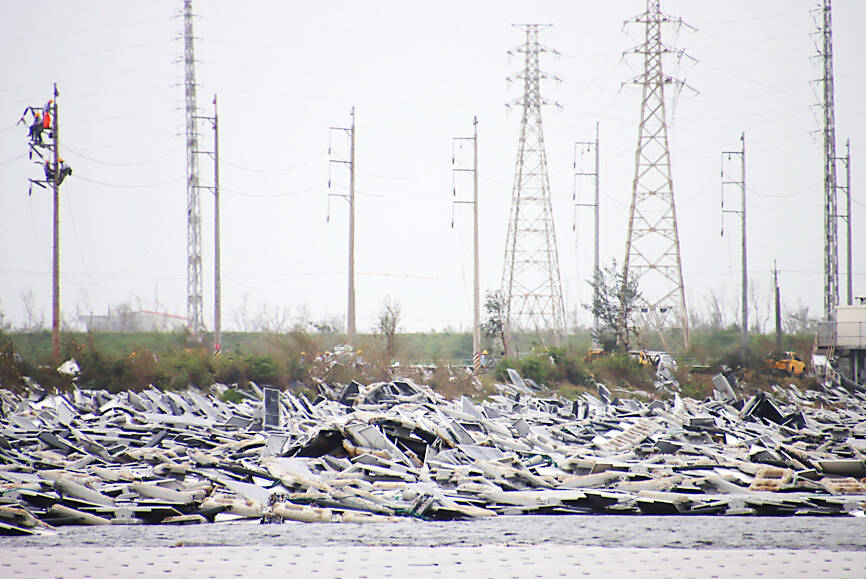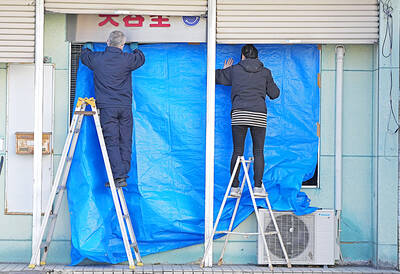Solar industry groups have denied claims that floating solar panels damaged by Typhoon Danas lacked storm protections or were an environmental risk.
Seven major solar power associations said in a joint statement last week that the damaged equipment accounted for less than 0.3 percent of total industry capacity.
They added that the broken panels are not a pollution risk and those over fish farms would not poison the fish.

Photo: Lin Yi-chang, Taipei Times
Industry operators are working closely with central and local governments to clean up, repair and inspect sites, it said.
They are also providing temporary power and supplies to local residents to minimize the impact on the community, it added.
Hengs Technology sent an energy storage cabinet to Tainan’s Houbi District (後壁) to provide residents with emergency power, the statement said.
The company immediately mobilized its technical team to prepare the equipment overnight, ensuring that residents could charge their devices, it quoted Hengs general manager Chou Hsiao-yen (周曉艷) as saying.
Taiwan’s total solar power capacity has reached 14.6 gigawatts, with the sites damaged by Danas accounting for about 35 megawatts, or 0.24 percent of total capacity, the statement said, citing the Energy Administration.
When Danas made landfall on Monday last week, solar power output peaked at 4.51 gigawatts, accounting for 15.2 percent of total electricity usage, demonstrating stable performance, it said.
Most solar panels currently in use are silicon-based, which must pass safety and anti-corrosion tests, making the risk of toxicity extremely low, it said.
Even if damaged panels are submerged in water, they are unlikely to pose any short-term environmental threat or poison farmed fish, it added.
Solar companies also helped with recovery efforts, assisting in cleanup, reconstruction and power restoration, the statement said.
Operators prioritized restoring panels over fish ponds, it said.
Sun Rise E&T Corp said that debris found along the coast of Pingtung Country’s Jiadong Township (佳冬) and Siaoliouciou Island (小琉球) after the typhoon was not solar panels, but floating walkway planks, which have been promptly cleared.
The solar panel manufacturer tested floating solar panels off Jiadong in April, but had removed the panels before the typhoon hit, it said.
Sun Rise said workers were conducting an island-wide inspection of Siaoliouciou to remove any debris and asked residents to report any they find.
The Coast Guard Administration said it did not find solar panel debris around Siaoliouciou.
Nevertheless, many people continue spread misinformation about the panels, the Ministry of Economic Affairs said.
If false rumors and misinformation continue, the Energy Administration would report such actions to the police, it said.
In other weather news, Tropical Storm Nari is not a threat to Taiwan, based on its positioning and trajectory, the Central Weather Administration (CWA) said yesterday.
Nari has strengthened from a tropical depression that was positioned south of Japan, it said.
The eye of the storm is about 2,100km east of Taipei, with a north-northeast trajectory moving toward the eastern seaboard of Japan, CWA data showed.
Based on its current path, the storm would not affect Taiwan, the agency said.
Additional reporting by Chen Yen-ting, with CNA

Taiwanese were praised for their composure after a video filmed by Taiwanese tourists capturing the moment a magnitude 7.5 earthquake struck Japan’s Aomori Prefecture went viral on social media. The video shows a hotel room shaking violently amid Monday’s quake, with objects falling to the ground. Two Taiwanese began filming with their mobile phones, while two others held the sides of a TV to prevent it from falling. When the shaking stopped, the pair calmly took down the TV and laid it flat on a tatami mat, the video shows. The video also captured the group talking about the safety of their companions bathing

US climber Alex Honnold is to attempt to scale Taipei 101 without a rope and harness in a live Netflix special on Jan. 24, the streaming platform announced on Wednesday. Accounting for the time difference, the two-hour broadcast of Honnold’s climb, called Skyscraper Live, is to air on Jan. 23 in the US, Netflix said in a statement. Honnold, 40, was the first person ever to free solo climb the 900m El Capitan rock formation in Yosemite National Park — a feat that was recorded and later made into the 2018 documentary film Free Solo. Netflix previewed Skyscraper Live in October, after videos

Starting on Jan. 1, YouBike riders must have insurance to use the service, and a six-month trial of NT$5 coupons under certain conditions would be implemented to balance bike shortages, a joint statement from transportation departments across Taipei, New Taipei City and Taoyuan announced yesterday. The rental bike system operator said that coupons would be offered to riders to rent bikes from full stations, for riders who take out an electric-assisted bike from a full station, and for riders who return a bike to an empty station. All riders with YouBike accounts are automatically eligible for the program, and each membership account

A classified Pentagon-produced, multiyear assessment — the Overmatch brief — highlighted unreported Chinese capabilities to destroy US military assets and identified US supply chain choke points, painting a disturbing picture of waning US military might, a New York Times editorial published on Monday said. US Secretary of Defense Pete Hegseth’s comments in November last year that “we lose every time” in Pentagon-conducted war games pitting the US against China further highlighted the uncertainty about the US’ capability to intervene in the event of a Chinese invasion of Taiwan. “It shows the Pentagon’s overreliance on expensive, vulnerable weapons as adversaries field cheap, technologically